Operation Dominic
The Johnston Island Atmospheric Nuclear Test Series
 The
Soviet Union had abrogated the 34 month old de facto nuclear testing moratorium
on 1 September 1961 by initiating an unprecedented series of atmospheric
nuclear tests. In response the U.S. began a frenzy of various named
operations testing their nuclear devices. The first deployment
of HMM-364 was in 1962 as an element of Joint Task Group 8.3 (JTG
8.3), commanded by Rear Admiral I. M. Mustin, and in support of Operation
Dominic. The squadron departed MCAF Santa Ana, California on
11 April '62 with twenty brand new HUS-1 (redesignated UH-34D on 1 Nov.
'62) aircraft aboard the LPH-5, USS Princeton.
The
Soviet Union had abrogated the 34 month old de facto nuclear testing moratorium
on 1 September 1961 by initiating an unprecedented series of atmospheric
nuclear tests. In response the U.S. began a frenzy of various named
operations testing their nuclear devices. The first deployment
of HMM-364 was in 1962 as an element of Joint Task Group 8.3 (JTG
8.3), commanded by Rear Admiral I. M. Mustin, and in support of Operation
Dominic. The squadron departed MCAF Santa Ana, California on
11 April '62 with twenty brand new HUS-1 (redesignated UH-34D on 1 Nov.
'62) aircraft aboard the LPH-5, USS Princeton.
 Upon
arriving in the vicinity of Johnston Island
it was found to be a small ancient atoll (80 million years old and perhaps
the most isolated reef in the world) with a recently constructed rocket
launching platform and a small airfield with an extremely short runway.
A description of landing a DC-8 was, "It's like landing on a table top.
Touch down on one side of the island, apply hard braking and hope you don't
run off the other side of the island." Prior to Operation Dominic,
Johnston Island had simply been a US Coast Guard facility for the
operation and maintenance of a LORAN station,
Upon
arriving in the vicinity of Johnston Island
it was found to be a small ancient atoll (80 million years old and perhaps
the most isolated reef in the world) with a recently constructed rocket
launching platform and a small airfield with an extremely short runway.
A description of landing a DC-8 was, "It's like landing on a table top.
Touch down on one side of the island, apply hard braking and hope you don't
run off the other side of the island." Prior to Operation Dominic,
Johnston Island had simply been a US Coast Guard facility for the
operation and maintenance of a LORAN station,
Operation Dominic was a series
of 36 atmospheric nuclear detonations (29 dropped from aircraft,
1 Polaris submarine launched ballistic missile, 1 surface ship launched
ASROC anti-submarine rocket , 1 launched atop a Nike Hercules rocket and
8 carried aloft by THOR rockets.) Except for the two submarine launched
tests, all the other detonations were in the vicinity of either Christmas
Island or Johnston Island. JTG 8.3, and HMM-364 as an element thereof,
were tasked to support the eight high altitude, above 100,000 feet, THOR
launched detonations from Johnston Island.
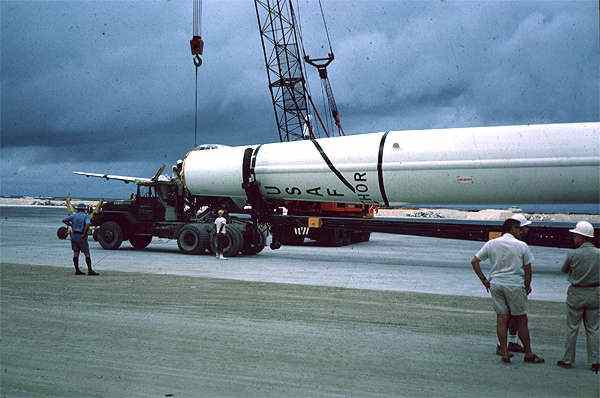 The
THOR
rocket launched tests were to evaluate the capabilities of an antiballistic
missile to operate in a nuclear environment and the vulnerability of
U.S. reentry vehicles (RVs) to survive a nearby nuclear blast. They
also provided information on the ability of a U.S. radar system to detect
and track RVs. Another goal was to discern the effects of a high
altitude blast on improved command and control systems, which were shown
to be vulnerable in earlier high altitude tests. The final goal was
to obtain information on the feasibility of testing in outer space.
The
THOR
rocket launched tests were to evaluate the capabilities of an antiballistic
missile to operate in a nuclear environment and the vulnerability of
U.S. reentry vehicles (RVs) to survive a nearby nuclear blast. They
also provided information on the ability of a U.S. radar system to detect
and track RVs. Another goal was to discern the effects of a high
altitude blast on improved command and control systems, which were shown
to be vulnerable in earlier high altitude tests. The final goal was
to obtain information on the feasibility of testing in outer space.
The Yankee Kilo Marines were
busy with administrative and logistical flights from the time they arrived.
They also conducted training flights that would prepare them for the recovery
of information recording devices which would further understanding of the
effects of high altitude nuclear explosions.
 Throughout
the entire time span of Operation Dominic the Squadron's commanding officer
was Major Manning T. Jannell, who later retired
as a Brigadier General. Maj. Jannell had definite ideas on how flights
were to be conducted and flight crews organized. Further, Maj. Jannell's
goal was to have 100% aircraft availability for each scheduled missile
launch. To accomplish this goal he assigned each aircraft a permanent
crew consisting of a pilot, copilot, crew chief and 1st mechanic.
The names of these crew members were stenciled
Throughout
the entire time span of Operation Dominic the Squadron's commanding officer
was Major Manning T. Jannell, who later retired
as a Brigadier General. Maj. Jannell had definite ideas on how flights
were to be conducted and flight crews organized. Further, Maj. Jannell's
goal was to have 100% aircraft availability for each scheduled missile
launch. To accomplish this goal he assigned each aircraft a permanent
crew consisting of a pilot, copilot, crew chief and 1st mechanic.
The names of these crew members were stenciled 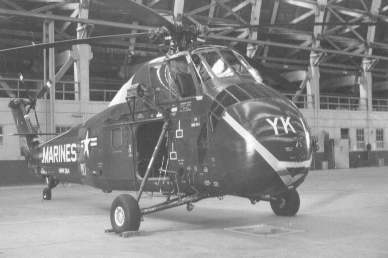 on
the side of the aircraft and this evoked a high degree of personal pride
within the crew. As a result the aircraft "belonged to them" and
they took great pleasure in keeping the aircraft looking
good and running in perfect condition. The crew spent a lot of
time waxing their aircraft which proved to serve the Squadron well on extended
sea duty by protecting the aircraft and keeping salt water corrosion to
a minimum. They knew the sound and feel of their "personal"
aircraft and a momentary spark plug misfire, or any other abnormal sound
or vibration, would bring all to immediate alert. When something
major such as an engine replacement was due, the permanent crew and others
pitched in at 110% effort. The engine was replaced, test flown and
was up for the next launch. The helicopter became a part of the crew's
being and Maj. Jannell's goal for 100% aircraft availability for the entire
duration of Operation Dominic was achieved.
on
the side of the aircraft and this evoked a high degree of personal pride
within the crew. As a result the aircraft "belonged to them" and
they took great pleasure in keeping the aircraft looking
good and running in perfect condition. The crew spent a lot of
time waxing their aircraft which proved to serve the Squadron well on extended
sea duty by protecting the aircraft and keeping salt water corrosion to
a minimum. They knew the sound and feel of their "personal"
aircraft and a momentary spark plug misfire, or any other abnormal sound
or vibration, would bring all to immediate alert. When something
major such as an engine replacement was due, the permanent crew and others
pitched in at 110% effort. The engine was replaced, test flown and
was up for the next launch. The helicopter became a part of the crew's
being and Maj. Jannell's goal for 100% aircraft availability for the entire
duration of Operation Dominic was achieved.
HMM-364's first direct nuclear
encounter, dubbed Bluegill, was the planned launch of a THOR with a W-50
warhead in a MK-4 RV on 3 June. This,
and all subsequent missions, called for twelve aircraft to evacuate all
non-essential personnel from Johnston Island to the USS Princeton prior
to launching the THOR. Additionally, these twelve aircraft were tasked
to fly designated search patterns in an attempt to retrieve NIKE missiles
which were to be shot through the blast/radiation zones of the high altitude
detonations. The other eight aircraft were divided into four sections
with the mission of retrieving three data collecting pods which were attached
to the side of the THOR rocket. These data pods were designed to
be jettisoned from the rocket at a predetermined altitude, which allowed
them to climb a bit higher from there own inertia and kinetic energy, as
the THOR continued to roar upward. These pods were designed to float
after free falling for a designated distance then parachutes would deploy
easing them back to the sea with the blast data stored in their recording
devices. Bluegill lifted off the launch pad at midnight (local time)
but problems had been encountered with the range safety radar prior
to launch, and five minutes after launch the Johnston Island missile tracking
system failed. Unable to monitor the missile's flight path, the range safety
officer destroyed it 10 minutes later, prior to warhead detonation.
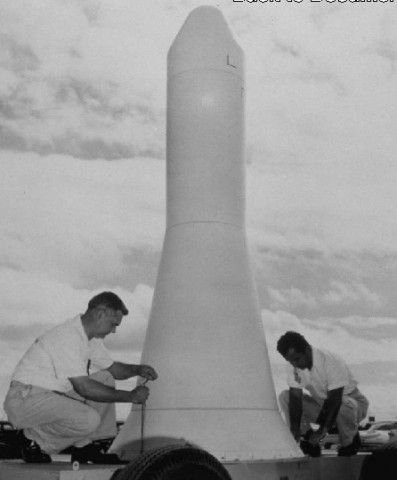 The
next high altitude THOR launched test, dubbed Starfish, was scheduled for
20 June. The rocket with the 1450 kt Starfish
device (W-49 warhead and the MK-4 RV) on it's nose was launched that
evening but the THOR missile engine cut out only 59 seconds after launch.
The range safety officer sent the destruct signal 65 seconds after launch,
and the missile was destroyed at approximately 35,000 ft. The warhead
high explosive detonated in 1-point safe fashion, destroying the warhead
without producing nuclear yield. Large pieces of the missile fell
back on Johnston Island, and more wreckage along with plutonium contamination
was found on nearby Sand Island.
The
next high altitude THOR launched test, dubbed Starfish, was scheduled for
20 June. The rocket with the 1450 kt Starfish
device (W-49 warhead and the MK-4 RV) on it's nose was launched that
evening but the THOR missile engine cut out only 59 seconds after launch.
The range safety officer sent the destruct signal 65 seconds after launch,
and the missile was destroyed at approximately 35,000 ft. The warhead
high explosive detonated in 1-point safe fashion, destroying the warhead
without producing nuclear yield. Large pieces of the missile fell
back on Johnston Island, and more wreckage along with plutonium contamination
was found on nearby Sand Island.
By July 9, 1962 another THOR had been delivered and
was configured the same as the previous Starfish test vehicle. This
rendition bore the name Starfish Prime. Again all non-essential personnel
(total personnel on Johnston Island numbered between 700 to 800) were evacuated
to the USS Princeton for the night launch of Starfish Prime. Many
of the people brought to the ship were relatively high paid scientists,
engineers etc. who had nowhere to go and nowhere to spend their salaries.
Rumor has it that many high stakes poker games could be found on the USS
Princeton as these folks waited for the all clear signal to return to their
work stations on the island.
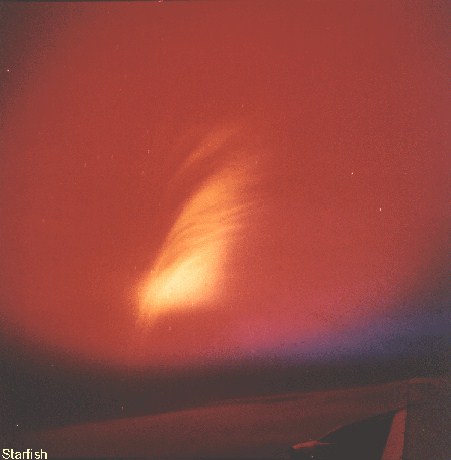 At
0900Z the THOR lifted off Johnston Island and roared to an altitude of
248 miles where the W-49 warhead/MK-4RV were released and detonated.
The test was quite spectacular with impressive light displays from an artificial
aurora lasting up to seven minutes. The electromagnetic pulse (EMP)
from the test sent power line surges throughout Oahu (800 miles away) knocking
out street lighting, blowing fuzes and circuit breakers, and triggering
burglar alarms. This was the highest altitude test and second largest
warhead detonated during the Johnston Island portion of Operation Dominic
and was probably the one that lead to newspaper headlines which read, "It
Was High Noon at 11:00 PM Today."
At
0900Z the THOR lifted off Johnston Island and roared to an altitude of
248 miles where the W-49 warhead/MK-4RV were released and detonated.
The test was quite spectacular with impressive light displays from an artificial
aurora lasting up to seven minutes. The electromagnetic pulse (EMP)
from the test sent power line surges throughout Oahu (800 miles away) knocking
out street lighting, blowing fuzes and circuit breakers, and triggering
burglar alarms. This was the highest altitude test and second largest
warhead detonated during the Johnston Island portion of Operation Dominic
and was probably the one that lead to newspaper headlines which read, "It
Was High Noon at 11:00 PM Today."
Soon after it was determined the THOR was launched
in a successful manner a barrage of NIKE missiles
were launched to gather additional data. The trajectory and splash
down points of these rockets and associated recording pods could not be
predicted as precisely as the pods from the THOR rockets. One atomic
veteran who was stationed on board another ship wrote. "The major
danger, we were told, would not be from the nuclear explosion, but from
the barrage of instrumented Nike missiles which would be launched to take
readings on the detonation. The impact points for these missiles
were unpredictable (I shot a Nike in the air, and where it fell…).
Heavy steel I-beams were stacked on top of the instrumented vans to minimize
damage should one or more of these unguided missiles land on us."
This observation was reinforced by the fact that none of the recording
devices of the NIKES were ever located by squadron flight crews pilots
even though extensive search patterns were flown attempting to recover
them.
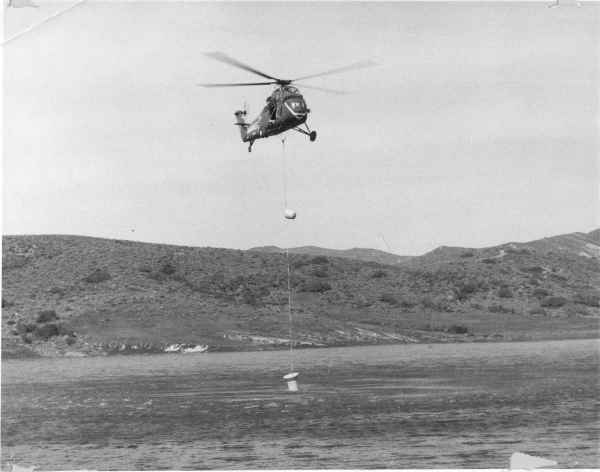 On
the other hand, the THOR's recording devices splash down points were more
predictable and the four sections assigned to retrieve them had much better
luck. When such a pod was located one aircraft would approach it
at an altitude of 10 to 12 feet and hover over it while the crew chief,
using a grappling hook and line, would snare the parachute to prevent it
from blowing up into the rotor system which would have certainly ruined
the crew's day, espically over water. Next the crew chief, using
another tool which resembled a "shepherds crook", would use the hook to
latch the free end of a 50 foot long sling to an attaching point on the
pod. The other end of the sling was fastened securely to the helicopter.
Once the hookup was made the pod was hauled back to Johnson Island trailing
below the aircraft. The training squadron
personnel received prior to commencing Operation Dominic aided them
in reducing the time spent at the 10 to 12 foot distance from the pod which
was contaminated with radio active particles. It was during Operation
Dominic that the squadron's commanding officer, Maj. Jannell, picked up
the nickname of "Hook."
On
the other hand, the THOR's recording devices splash down points were more
predictable and the four sections assigned to retrieve them had much better
luck. When such a pod was located one aircraft would approach it
at an altitude of 10 to 12 feet and hover over it while the crew chief,
using a grappling hook and line, would snare the parachute to prevent it
from blowing up into the rotor system which would have certainly ruined
the crew's day, espically over water. Next the crew chief, using
another tool which resembled a "shepherds crook", would use the hook to
latch the free end of a 50 foot long sling to an attaching point on the
pod. The other end of the sling was fastened securely to the helicopter.
Once the hookup was made the pod was hauled back to Johnson Island trailing
below the aircraft. The training squadron
personnel received prior to commencing Operation Dominic aided them
in reducing the time spent at the 10 to 12 foot distance from the pod which
was contaminated with radio active particles. It was during Operation
Dominic that the squadron's commanding officer, Maj. Jannell, picked up
the nickname of "Hook."
 Bluegill
Prime, the second attempt to launch the payload which failed on 3 June
was scheduled for 23:15 (local) on 25 July. It too was a genuine
disaster. The THOR missile was carrying one pod, two re-entry vehicles
(all heavily instrumented) and the warhead. The missile engine malfunctioned
immediately after ignition, and the range safety officer fired the destruct
system while the missile was still on the launch pad. Dale
K. Olson aboard the U.S.S. John S. McCain, DL-3 remembers the night, "I
got a real sick feeling knowing that there was a fully active A-bomb on
the rocket. It gave a new meaning to 'Put your head between your
legs and kiss your ass good-bye.' I monitored the count down and
opened the outside hatch (against orders - but what the hell, if it blew
who would know) when we heard the abort code. Hell of a fire ball!"
The Johnston Island launch complex was demolished.
This proved the wisdom of evacuating all non-essential personnel from the
island. According to the Los Angeles Times, "There was no
release of radiation and no personnel were injured." True
the warhead did not detonate but when the rocket was destroyed, the warhead
was also destroyed and plutonium was scattered all over Johnston Island.
There was speculation that the tests would be canceled. In
any event the USS Princeton would not be required in the area until the
island was cleaned up and another launch pad built so she departed for
San Diego with an interim stop in Hawaii.
Bluegill
Prime, the second attempt to launch the payload which failed on 3 June
was scheduled for 23:15 (local) on 25 July. It too was a genuine
disaster. The THOR missile was carrying one pod, two re-entry vehicles
(all heavily instrumented) and the warhead. The missile engine malfunctioned
immediately after ignition, and the range safety officer fired the destruct
system while the missile was still on the launch pad. Dale
K. Olson aboard the U.S.S. John S. McCain, DL-3 remembers the night, "I
got a real sick feeling knowing that there was a fully active A-bomb on
the rocket. It gave a new meaning to 'Put your head between your
legs and kiss your ass good-bye.' I monitored the count down and
opened the outside hatch (against orders - but what the hell, if it blew
who would know) when we heard the abort code. Hell of a fire ball!"
The Johnston Island launch complex was demolished.
This proved the wisdom of evacuating all non-essential personnel from the
island. According to the Los Angeles Times, "There was no
release of radiation and no personnel were injured." True
the warhead did not detonate but when the rocket was destroyed, the warhead
was also destroyed and plutonium was scattered all over Johnston Island.
There was speculation that the tests would be canceled. In
any event the USS Princeton would not be required in the area until the
island was cleaned up and another launch pad built so she departed for
San Diego with an interim stop in Hawaii.
When the Squadron arrived at Pearl Harbor a number
of their new HUS-1's were flown to K-Bay and exchanged for older aircraft
of HMM-161. The command could not believe the superb condition and
appearance of the aircraft delivered to them by HMM-364. A letter
from the Commanding Officer of HMM-161 was sent to Maj. Jannell via the
chain of command up to the Commandant and back to HMM-364. The myriad
of endorsements complementing the Marines of HMM-364 made them very proud
of the effort they expended in keeping the aircraft in top notch shape
an providing 100% availability for the first portion of Operation Dominic.
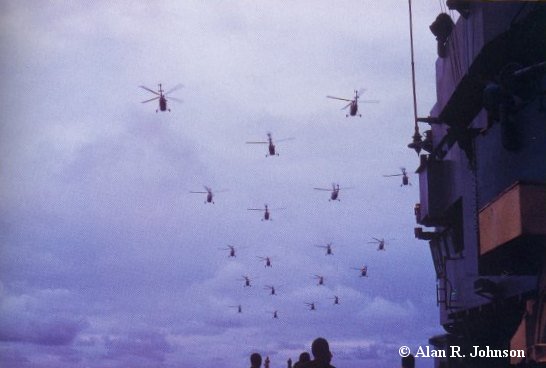 The
"Yankee Kilo Marines" were advised that a three week cleanup of Johnston
Island was complete and another launch pad was being constructed.
Therefore, they soon found themselves embarking aboard the brand new LPH-
2, USS Iwo Jima (Ninteen aircraft formation)
for transit back to the Johnston Island arriving in time for the third
attempt to launch the Bluegill device which had now twice been unsuccessful.
This launch, named Bluegill Double Prime, was rocketed aloft at 21:14 (local
time) on 15 October 1962. Between 86 to 90 seconds into the flight
the THOR again failed and the missile began tumbling. It was destroyed
by remote control 156 seconds after launch and some of its radioactive
debris fell back onto Johnston Island.
The
"Yankee Kilo Marines" were advised that a three week cleanup of Johnston
Island was complete and another launch pad was being constructed.
Therefore, they soon found themselves embarking aboard the brand new LPH-
2, USS Iwo Jima (Ninteen aircraft formation)
for transit back to the Johnston Island arriving in time for the third
attempt to launch the Bluegill device which had now twice been unsuccessful.
This launch, named Bluegill Double Prime, was rocketed aloft at 21:14 (local
time) on 15 October 1962. Between 86 to 90 seconds into the flight
the THOR again failed and the missile began tumbling. It was destroyed
by remote control 156 seconds after launch and some of its radioactive
debris fell back onto Johnston Island.
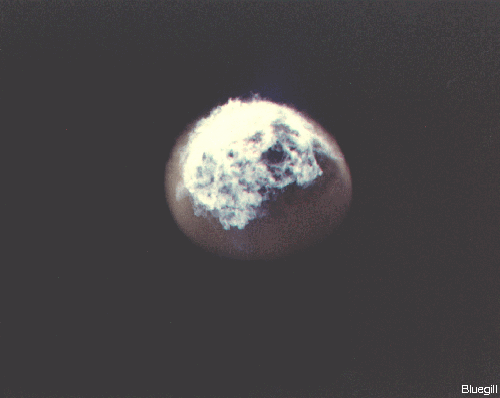 Bluegill
Triple Prime, on 26 Oct '62, was the fourth and finally successful
launch of this high altitude test using the W-50 warhead in a Mk 4 RV.
The 1000 kt warhead detonated at an altitude of 31 miles, approximately
19 miles south-southwest of Johnston Island. This burst occurred
low enough in the atmosphere for fireball formation to occur, and observers
saw a brilliant white flash and noticeable heat pulse on bare skin.
A slightly distorted bright moon-like sphere was seen, yellow at first,
then gradually showing green, pink, and violet hues. Blue-purple
streamers were formed. A bright glow persisted for 30 minutes, at
times bright enough to read a watch face in the dark. The fireball
was seen in Hawaii also.
Bluegill
Triple Prime, on 26 Oct '62, was the fourth and finally successful
launch of this high altitude test using the W-50 warhead in a Mk 4 RV.
The 1000 kt warhead detonated at an altitude of 31 miles, approximately
19 miles south-southwest of Johnston Island. This burst occurred
low enough in the atmosphere for fireball formation to occur, and observers
saw a brilliant white flash and noticeable heat pulse on bare skin.
A slightly distorted bright moon-like sphere was seen, yellow at first,
then gradually showing green, pink, and violet hues. Blue-purple
streamers were formed. A bright glow persisted for 30 minutes, at
times bright enough to read a watch face in the dark. The fireball
was seen in Hawaii also.
At dawn the following morning
the search for the three recording devices which had been attached to the
THOR was underway. The pods, which floated only a few
inches out of the water, were equipped with a radio transmitter that emitted
a signal which was received by two directional antennas attached to each
main gear of the helicopter and connected to an oscilloscope next to the
crew chief. The crew chief could tell if they were flying toward,
or away from, the pod by viewing the strength of the signal. The
signal would create a bar on the scope and by keeping the bar centered,
with verbal instructions to the pilot, the crew chief could direct the
helicopter right to the floating pod. As each was found the lead
aircraft of the section would hover low while the crew chief, using the
"shepherds hook," attached the loose end of the strap to the device.
The crew chief would then verbally direct the pilot to commence lifting
straight up, lifting straight up and out of ground effect into the "Dead
Man's Curve." (Hovering and/or very slow airspeed at low altitude eliminates
the possibility of a safe autoration in the event of engine failure and
operations within this environment is known as the "Dead Man's Curve.")
At approximately 50 feet above the water all the slack was out of the lifting
strap. Then with a jolt the helicopter would abruptly stop ascending
as if it was anchored to the bottom of the ocean for the pod alone, without
all the sea water it had accumulated, weighed approximately 2,000 pounds.
The pilot would raise the collective a bit more as he twisted the motorcycle
type throttle clockwise to wind the Pratt and Whitney R-1820 engine up
to its red line of 2,850 RPM and 54" of manifold pressure which developed
the maximum rated 1,525 shaft horsepower. Then, so very slowly the
helicopter with its remaining fuel load and crew of four began ascending
again lifting the water laden pod from the sea with streams of water pouring
from it. Once the pod was out of the sea and the water drained, the
cyclic stick was moved unpreceptively forward to produce the slight forward
component of lift which eased the aircraft forward, allowed it to gain
translational lift, and accellerate to 60 knots which finally placed
the aircrafrt in a safe operating environment outside of the "Dead Man's
Curve." The pod was hauled to Johnston Island at this relatively
slow speed of approximately 60 knots because, with the total weight of
aircraft and the pod, the engine was not capable of greater airspeed while
at the same time maintaining an altitude of approximately 100 feet.
Upon reaching Johnston Island the pods were placed in protective mounds
which were lined with lead. Each of the other two pods were recovered
in the same fashion. The crews searching for the Nikes and their
recordings were not so lucky again.
 The
test on 30 October named
Housatonic was the largest
nuclear warhead detonated (8,300 kt) in the Johnston Island area when HMM-364
was present. It was not launched aboard a THOR but rather air delivered
by a B-52 and was detonated at an altitude of 12,130 feet.
The device was a MK-36 which had a diameter of 56.2 inches, a length
of 147.9 inches and weighed 7,139.55 pounds. It was the last air
dropped weapon of the U.S. atmospheric test series and was spectacularly
successful. It is believed the photograph attached to this paragraph
is the detonation of Housatonic, but it may be Bumping which was air dropped
on 6 October. The interesting point of the photograph, though not
completely discernible in the lower right portion, shows members of the
USS Iwo Jima's crew lined up on the flight deck to observe the blast.
The
test on 30 October named
Housatonic was the largest
nuclear warhead detonated (8,300 kt) in the Johnston Island area when HMM-364
was present. It was not launched aboard a THOR but rather air delivered
by a B-52 and was detonated at an altitude of 12,130 feet.
The device was a MK-36 which had a diameter of 56.2 inches, a length
of 147.9 inches and weighed 7,139.55 pounds. It was the last air
dropped weapon of the U.S. atmospheric test series and was spectacularly
successful. It is believed the photograph attached to this paragraph
is the detonation of Housatonic, but it may be Bumping which was air dropped
on 6 October. The interesting point of the photograph, though not
completely discernible in the lower right portion, shows members of the
USS Iwo Jima's crew lined up on the flight deck to observe the blast.
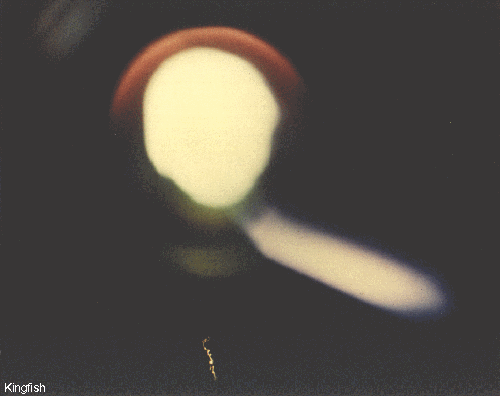 Kingfish
was
the last THOR launched device which was detonated
on 1 November. The detonation occurred at an altitude of 60 miles.
The dramatic visual (and other) effects were observed over much of the
central Pacific. The explosion appeared as a bright yellow glow, at first
circular, but elongating along a south-to-northwest axis. The long
axis reached 125 miles after 30 minutes, and eventually reached 185 miles.
The glow persisted for at least 1.5 hours. On Johnston Island a yellow-white
luminous circle with intense purple streamers was visible for the first
minute. Brilliant streamers (beta particle auroras) were seen going north
and south from Maui. At Oahu a bright flash was seen, and after about
ten seconds a great white ball was seen rising slowly out of the sea and
remained visible for several minutes. Another major effect of this
shot was the widespread disturbance of the ionosphere and the consequent
disruption of radio communications over the central Pacific, which lasted
at least three hours.
Kingfish
was
the last THOR launched device which was detonated
on 1 November. The detonation occurred at an altitude of 60 miles.
The dramatic visual (and other) effects were observed over much of the
central Pacific. The explosion appeared as a bright yellow glow, at first
circular, but elongating along a south-to-northwest axis. The long
axis reached 125 miles after 30 minutes, and eventually reached 185 miles.
The glow persisted for at least 1.5 hours. On Johnston Island a yellow-white
luminous circle with intense purple streamers was visible for the first
minute. Brilliant streamers (beta particle auroras) were seen going north
and south from Maui. At Oahu a bright flash was seen, and after about
ten seconds a great white ball was seen rising slowly out of the sea and
remained visible for several minutes. Another major effect of this
shot was the widespread disturbance of the ionosphere and the consequent
disruption of radio communications over the central Pacific, which lasted
at least three hours.
Upon recovering the recording pods of Kingfish, the
squadron's participation in Operation Dominic I was ended and the USS Iwo
Jima steamed away from Johnston Island. Additionally, the thermonuclear
frenzy of superpower saber rattling between the United States and the Soviet
Union ended relative to atmospheric testing (Underground testing in Nevada
continued and was named Operation Dominic II). HMM-364 arrived back
in California just in time for celebrating the Marine Corps' birthday.
Epilogue
 Through
the release of atomic energy, our generation has brought into the world
the most revolutionary force since prehistoric man's discovery of fire.
Through
the release of atomic energy, our generation has brought into the world
the most revolutionary force since prehistoric man's discovery of fire.
This basic force of the universe cannot be fitted
into the outmoded concept of narrow nationalisms. For there is no
secret and there is no defense; there is no possibility of control except
through the aroused understanding and insistence of the peoples of the
world. We scientists recognize our inescapable responsibility to
carry to our fellow citizens an understanding of atomic energy and its
implication for society. In this lies our only security and our only
hope - we believe that an informed citizenry will act for life and not
for death.
I do not know with what weapons World War 3 will
be fought, but World War 4 will be fought with sticks and stones.
A. Einstein
Click below for
Warren R. Smith's Memories
of Operation Dominic
Information provided by:
Donald L. "Crook" Crooker, former
Cpl. USMC
James T. "Jim" Shepherd, 1stSgt.
USMC (Ret)
Dennis T. "Denny" McKee, Maj. USMC
(Ret)
Warren R. Smith, former Cpl. USMC
El Toro Flight Jacket, Dec. '62
Los Angeles Times, 26 July '62
Los Angeles Times, 11 Sep. '62
Enviorweb.org
Images provided by:
Dennis T. "Denny" McKee, Maj. USMC
(Ret)
Jim Barrow, Air Force Communications
Service
Public domain photographs of neuclear
blasts and warheads by Department of Energy/Department of Defense.
Enviorweb.org
Home
 The
Soviet Union had abrogated the 34 month old de facto nuclear testing moratorium
on 1 September 1961 by initiating an unprecedented series of atmospheric
nuclear tests. In response the U.S. began a frenzy of various named
operations testing their nuclear devices. The first deployment
of HMM-364 was in 1962 as an element of Joint Task Group 8.3 (JTG
8.3), commanded by Rear Admiral I. M. Mustin, and in support of Operation
Dominic. The squadron departed MCAF Santa Ana, California on
11 April '62 with twenty brand new HUS-1 (redesignated UH-34D on 1 Nov.
'62) aircraft aboard the LPH-5, USS Princeton.
The
Soviet Union had abrogated the 34 month old de facto nuclear testing moratorium
on 1 September 1961 by initiating an unprecedented series of atmospheric
nuclear tests. In response the U.S. began a frenzy of various named
operations testing their nuclear devices. The first deployment
of HMM-364 was in 1962 as an element of Joint Task Group 8.3 (JTG
8.3), commanded by Rear Admiral I. M. Mustin, and in support of Operation
Dominic. The squadron departed MCAF Santa Ana, California on
11 April '62 with twenty brand new HUS-1 (redesignated UH-34D on 1 Nov.
'62) aircraft aboard the LPH-5, USS Princeton.
 Upon
arriving in the vicinity of
Upon
arriving in the vicinity of  The
The
 Throughout
the entire time span of Operation Dominic the Squadron's commanding officer
was
Throughout
the entire time span of Operation Dominic the Squadron's commanding officer
was  on
the side of the aircraft and this evoked a high degree of personal pride
within the crew. As a result the aircraft "belonged to them" and
they took great pleasure in keeping the
on
the side of the aircraft and this evoked a high degree of personal pride
within the crew. As a result the aircraft "belonged to them" and
they took great pleasure in keeping the  The
next high altitude THOR launched test, dubbed Starfish, was scheduled for
20 June. The rocket with the
The
next high altitude THOR launched test, dubbed Starfish, was scheduled for
20 June. The rocket with the  At
0900Z the THOR lifted off Johnston Island and roared to an altitude of
248 miles where the W-49 warhead/MK-4RV were released and detonated.
The test was quite spectacular with impressive light displays from an artificial
aurora lasting up to seven minutes. The electromagnetic pulse (EMP)
from the test sent power line surges throughout Oahu (800 miles away) knocking
out street lighting, blowing fuzes and circuit breakers, and triggering
burglar alarms. This was the highest altitude test and second largest
warhead detonated during the Johnston Island portion of Operation Dominic
and was probably the one that lead to newspaper headlines which read, "It
Was High Noon at 11:00 PM Today."
At
0900Z the THOR lifted off Johnston Island and roared to an altitude of
248 miles where the W-49 warhead/MK-4RV were released and detonated.
The test was quite spectacular with impressive light displays from an artificial
aurora lasting up to seven minutes. The electromagnetic pulse (EMP)
from the test sent power line surges throughout Oahu (800 miles away) knocking
out street lighting, blowing fuzes and circuit breakers, and triggering
burglar alarms. This was the highest altitude test and second largest
warhead detonated during the Johnston Island portion of Operation Dominic
and was probably the one that lead to newspaper headlines which read, "It
Was High Noon at 11:00 PM Today."
 On
the other hand, the THOR's recording devices splash down points were more
predictable and the four sections assigned to retrieve them had much better
luck. When such a pod was located one aircraft would approach it
at an altitude of 10 to 12 feet and hover over it while the crew chief,
using a grappling hook and line, would snare the parachute to prevent it
from blowing up into the rotor system which would have certainly ruined
the crew's day, espically over water. Next the crew chief, using
another tool which resembled a "shepherds crook", would use the hook to
latch the free end of a 50 foot long sling to an attaching point on the
pod. The other end of the sling was fastened securely to the helicopter.
Once the hookup was made the pod was hauled back to Johnson Island trailing
below the aircraft. The
On
the other hand, the THOR's recording devices splash down points were more
predictable and the four sections assigned to retrieve them had much better
luck. When such a pod was located one aircraft would approach it
at an altitude of 10 to 12 feet and hover over it while the crew chief,
using a grappling hook and line, would snare the parachute to prevent it
from blowing up into the rotor system which would have certainly ruined
the crew's day, espically over water. Next the crew chief, using
another tool which resembled a "shepherds crook", would use the hook to
latch the free end of a 50 foot long sling to an attaching point on the
pod. The other end of the sling was fastened securely to the helicopter.
Once the hookup was made the pod was hauled back to Johnson Island trailing
below the aircraft. The 
 The
"Yankee Kilo Marines" were advised that a three week cleanup of Johnston
Island was complete and another launch pad was being constructed.
Therefore, they soon found themselves embarking aboard the brand new LPH-
2, USS Iwo Jima
The
"Yankee Kilo Marines" were advised that a three week cleanup of Johnston
Island was complete and another launch pad was being constructed.
Therefore, they soon found themselves embarking aboard the brand new LPH-
2, USS Iwo Jima 
 The
test on 30 October named
The
test on 30 October named

